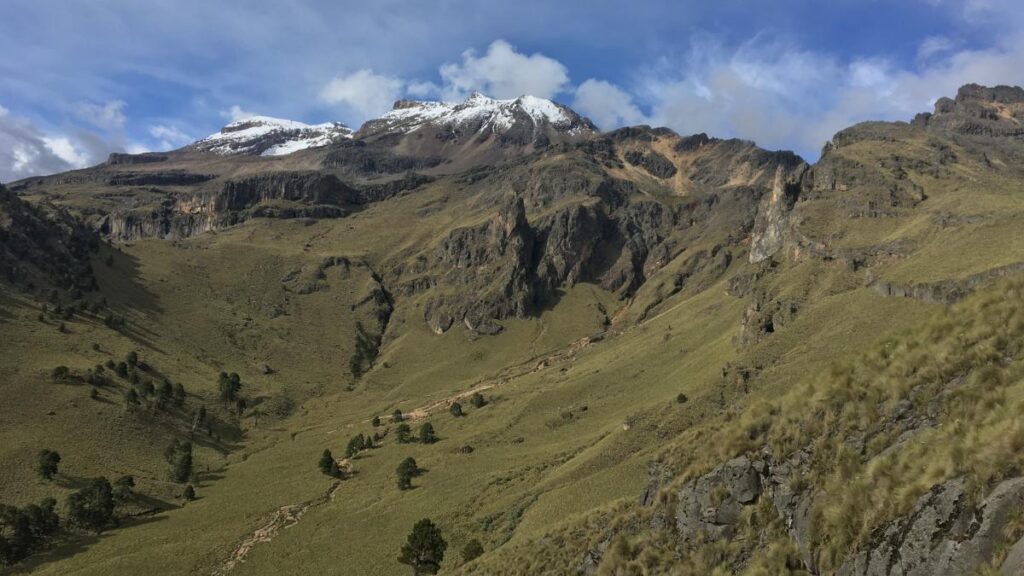Just two hours away from the hustle and bustles of Mexico City you will find Iztaccíhuatl–Popocatépetl National Park, which is the oldest national park in Mexico.
It was established on November 8, 1935, to protect some of the most unique ecology in the country in the lower cloud forests and high alpine valleys between the twin volcanos.
The summit of the Popocatépetl Volcano is 5,393 m (17,693 feet) and it is known locally as El Popo. Its name is derived from the Nahuatl word for “smoking mountain” and it features prominently in the ancient mythologies of the Aztec, Toltec and other Nahuatl-speaking peoples of Central Mexico.
Popocatépetl is volcanically active, with the latest eruptive period extending from 2005 to the present. This makes it dangerous to climb but neighbouring Iztaccíhuatl has the best views of this smoking volcano and the surrounding valleys.

The Iztaccíhuatl Volcano is the third-highest mountain in Mexico at 5,230 m (17,160 feet). The rain and snowfall and glacial melt on the slopes of Iztaccíhuatl and Popocatépetl give rise to many mountain streams and rivers that provide the sunny high altitude Central Valleys of Mexico with much-needed water.
On a clear day from the upper alpine meadows and ridgelines of Iztaccíhuatl–Popocatépetl National Park you can see the largest pyramid (and most visited archeological site) in the Western Hemisphere at Teotihuacán to the northwest and the largest pyramid by volume in the world to the southeast known as the Great Pyramid of Cholula (just west of the city of Puebla).
From Iztaccíhuatl, you can also see the highest mountain in Mesoamerica known as Pico de Orizaba (derived from the Nahuatl for “Star Mountain”) to the west, which stands at 5,636 m (18,491 feet) making it the third tallest mountain in North America after Denali in Alaska and Mount Logan in Canada’s Yukon territories.
Pico de Orizaba is a much more difficult hike and generally only summited by expert mountaineers so if you want an epic hike while you are visiting Mexico City then my recommendation is hike Iztaccíhuatl.
How To Hike The Iztaccíhuatl and Popocatépetl Volcano:
The summits of these towering volcanos are extremely high elevation so it is recommend to hire a guide for safety and to learn about the unique ecology of this high mountain area.
The easiest of the two volcanos to climb is Iztaccihuatl, which is a dormant volcano and it over epic views of the Central Valleys of Mexico, Mexico City and the slightly higher Popocatépetl.
Popocatépetl is more dangerous to climb not only because it is higher but it is active and constantly erupting so you have to pay close attention to the weather and volcanic eruptions.
The hike to Iztaccíhuatl’s summit:

Length: 12.2 km
Elevation gain: 1,337 m
Route type: Out & back
Trail Map: AllTrails
This alpine route to the summit of Iztaccíhuatl is highly challenging and is not for beginners. Fortunately, there are lots of epic hikes for all skill levels in the lower cloud forests and the upper alpine meadows.
It is recommended that you hire a professional hiking guide to summit the volcano. The trail will take you up a considerable ascent, and the biggest challenge you will face is acclimatizing to the change in altitude.
Before making the ascent, climbers must register and pay the park entrance fee at the Iztaccíhuatl-Popocatépetl National Park office on the southeast side of the town of Amecameca’s zocalo. Alternatively, you can purchase the permit at the ranger station at the Paso de Cortés.
The hike up to Iztaccíhuatl starts at the La Joyita base camp. It is suggested that you camp here for a few days to acclimatize and start your hike between midnight and 2am because the total trip will take 12-15 hours. The long time is due to the difficult conditions: landslides, snow, mud, false peaks, and the crossing of a glacier.
The first part up to the campground at El Refugio is arduous, and the second part to the summit is particularly challenging.
Alternatively, you can hike the 3-hour La Joyita – Portillo 3 route, which takes you from the La Joyita base camp where most ascents of Iztaccíhuatl begin to the third alpine pass on the way to the summit.
The best climbing weather for Iztaccihuatl usually falls from November to March.
The hike to Popocatépetl’s summit:
The volcano is monitored by the National Autonomous University of Mexico (UNAM) and a webcam provides 24-hour coverage but it’s not recommend to hike this mountain without an expert mountain guide as it is highly active and very dangerous.
The Aztec Mythology of Iztaccíhuatl–Popocatépetl
In ancient Nahua legend, there was a romance of the princess Iztaccíhuatl and the warrior Popocatépetl.

In Aztec mythology, Iztaccíhuatl was a princess who fell in love with one of her father’s warriors, Popocatépetl. The emperor sent Popocatépetl to war in Oaxaca, promising him Iztaccíhuatl as his wife when he returned (which Iztaccíhuatl’s father presumed he would not).
Iztaccíhuatl was falsely told that Popocatépetl had died in battle, and believing the news, she died of grief. When Popocatépetl returned to find his true love dead, he took her body to a spot outside Tenochtitlan (the great Aztec city upon which Mexico City is built) and kneeled by her grave. The gods covered them with snow and changed them into mountains.
Iztaccíhuatl’s mountain is called “The Sleeping Woman” or “The White Lady” because it resembles the princess lying on her back, and it is often covered with snow while Popocatépetl became an active volcano, raining fire on Earth in blind rage at the loss of his beloved.
The Aztecs have many fascinating myths and a different way of seeing the world that is unique to the indigenous peoples of Mesoamerica so we’re happy to visit such a storied place during the annual Day of the Dead celebration for our Mexico Hiking And Mushroom Foraging Retreat.
The Flora, Fauna And Fungi of Iztaccíhuatl–Popocatépetl National Park

While only 2 hours away from the center of one of the world’s largest cities, Iztaccíhuatl–Popocatépetl National Park has an incredible diversity of flora, fauna and fungi.
Nahuatl-speaking people have been collecting plant medicines and sacred mushrooms in these forests for millennia. Researchers have documented evidence that the Aztecs climbed the volcanos and they were sacred places to worship their gods, perform religious ceremonies and connect with the animistic energy of Mother Earth.
The predominant ecosystem zones in the park are montane conifer forests and alpine grasslands. The conifer forests consist mainly of Pine and Fir trees that extend from the lower limits of the park up to 4000 meters elevation.
Above that you have high alpine and sub-alpine grasslands and wildflower meadows known as the Zacatonal found between 3500 and 4350 meters elevation. The high alpine reas above 4350 meters, which include the peaks of Popocatépetl and Iztaccíhuatl, are mostly barren rock and permanent ice and snow.
You will also find the last of Mexico’s glaciers here, which will be gone forever by the end of the decade.
The Flora And Plant Medicines:
Some of the plant medicines, wildflowers and rare plants that grow here are:
1. Hen-And-Chickens Echeveria (Echeveria secunda)
2. Toad’s Herb (Eryngium carlinae)
3. Cardinal Sage (Salvia fulgens)
4. Santa Catalina Paintbrush (Castilleja tenuiflora)
5. Spotted Coralroot (Corallorhiza maculata)
6. Bird’s-Eye Speedwell (Veronica persica)
7. Blue Spiderwort (Commelina tuberosa)
8. Ghost Pipe (Hypopitys monotropa)
9. Cotztomatl (Physalis coztomatl)
10. Scarlet Pimpernel (Lysimachia arvensis)
The Fungi And Sacred Mushrooms:
Prominent Mycologist Alan Rockefeller has documented the incredible variety of mushrooms that grow in the cloud forests on the slopes of the Iztaccíhuatl and Popocatépetl volcanos.
In the lush cloud forests, you will find some of the sacred mushrooms used by the Aztec elite in their ceremonies. In ancient times, psychedelic mushrooms played a crucial role in the religions of Aztec, Toltec and Mayan peoples of Mexico.
Some of the most fascinating mushrooms found here include:
1. Flammulina mexicana
2. Fly Agaric (Amanita muscaria)
3. Psathyrella spacidea
4. Boletus edulis
5. Cordyceps entomorrhiza
6. Mycena acicula
7. Ruby Porcini (Boletus rubriceps)
8. Bas’ Caesar (Amanita basii)
9. Shellfish-scented Russula (Russula xerampelina)
10. Collared Earthstar (Geastrum triplex)
The Wild Mammals:
There are 48 species of wild mammals have been recorded in the park including:
1. Bobcats (Lynx rufus)
2. Coyotes (Canis latrans)
3. Gray Fox (Urocyon cinereoargenteus)
4. American badger (Taxidea taxus berlandieri)
5. Orizaba long-tailed shrew (Sorex orizabae)
6. Phillips’s kangaroo rat (Dipodomys phillipsii)
7. Endangered volcano rabbit (Romerolagus diazi)
8. Ringtail (Bassariscus astutus)
9. Merriam’s Pocket Gopher (Cratogeomys merriami)
10. Eastern Cottontail (Sylvilagus floridanus)
The Birds Of The Cloud Forests:
The cloud forests on the slopes of the two volcanos also provide some of the best birdwatching near Mexico City with a variety of colorful species including:
1. Broad-billed Hummingbird (Cynanthus latirostris)
2. Red Crossbill (Loxia curvirostra)
3. Red-tailed Hawk (Buteo jamaicensis)
4. Red Warbler (Cardellina rubra)
5. Western Bluebird (Sialia mexicana)
6. Steller’s Jay (Cyanocitta stelleri)
7. Great Horned Owl (Bubo virginianus)
8. Broad-tailed Hummingbird (Selasphorus platycercus)
9. Ruby-throated Hummingbird (Archilochus colubris)
10. Blue-throated Mountain-Gem (Lampornis clemenciae)
Experience The Natural Wonders of Iztaccíhuatl–Popocatépetl National Park

If you’re planning to visit Mexico City and you love hiking epic mountains then you’ll definitely want to climb Iztaccíhuatl.
If you are traveling internationally from near sea level, you may also want to spend a few days in Mexico City, which is one of the highest cities in the world at 2,240 meters (7,349 feet).
I recommend staying in one of the neighbourhoods like Roma or La Condesa near Mexico City’s Bosque de Chapultepec, which is double the size and even more interesting than New York’s Central Park.
The best place to base yourself before hiking Iztaccíhuatl is near the Zócalo in the picturesque town of Amecameca below the twin volcanos.
I hope you enjoyed this guide to hiking Iztaccíhuatl–Popocatépetl National Park near Mexico City.
- 10 Interesting Facts And Statistics About Ecotourism In 2025 - January 22, 2025
- How Ecotourism Can Help Sustainably Develop Rural Communities - December 19, 2024
- Mushroom Identification Tour In Medellin, Colombia’s Parque Arví - December 18, 2024




